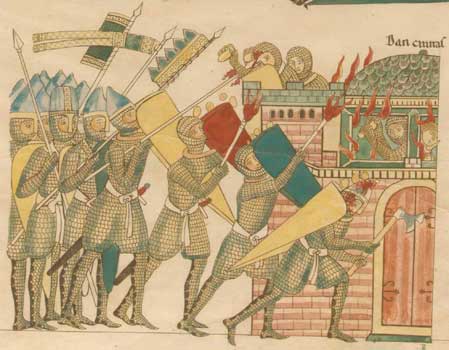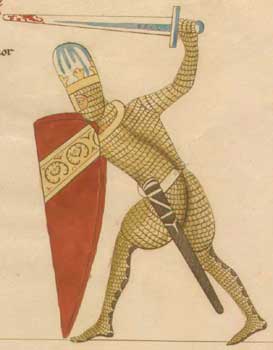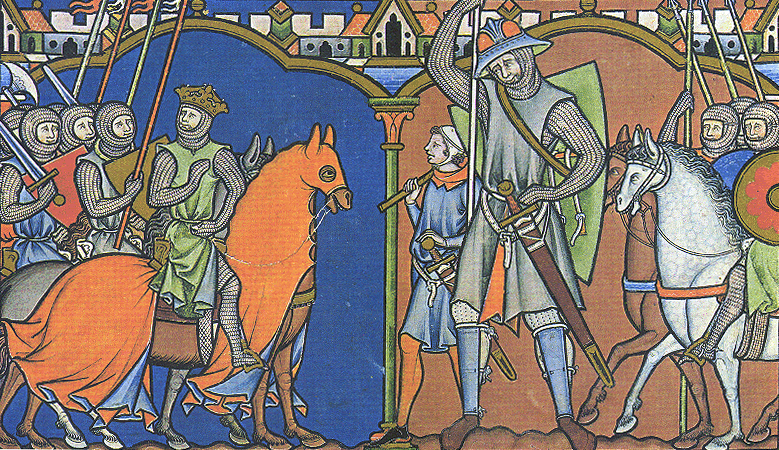| Author |
Message |
|
Jeremy V. Krause
|
 Posted: Fri 19 May, 2006 9:43 am Post subject: leg protection in 11-1200s Posted: Fri 19 May, 2006 9:43 am Post subject: leg protection in 11-1200s |
 |
|
Hello everyone,
I am perplexed as to the question of lower leg protection in the high midieval (first Crusade) era. During the Roman eral or during certain segments of it metal greeves seem rather common, and yet during the viking and high middle ages there is no evidence of this. What's the deal? Are we missing specimens? What do others think is the proper leg protection of this era for a kit?
Thanks.,
Jeremy
|
|
  |
 |
Addison C. de Lisle

|
|
   |
 |
Jonathan Blair

|
 Posted: Fri 19 May, 2006 11:35 am Post subject: Posted: Fri 19 May, 2006 11:35 am Post subject: |
 |
|
I believe that maille chausses were the standard for the European knight during the first crusade. Plate started showing up a little later.
"Think not that I am come to send peace on earth: I came not to send peace, but a sword." - The Lord Jesus Christ, from The Gospel According to Saint Matthew, chapter x, verse 34, Authorized Version of 1611
|
|
  |
 |
Chuck Russell

|
 Posted: Fri 19 May, 2006 11:56 am Post subject: Posted: Fri 19 May, 2006 11:56 am Post subject: |
 |
|
mail. thats about it and thats closer to crusade rather than norman finds.
theres always the question on the splinted greeves from the byz. era
the metal in roman was bronze or iron. seems to be a lack of it in europe for larger items on the body till later
|
|
    |
 |
|
Eric Allen
|
 Posted: Fri 19 May, 2006 11:57 am Post subject: Posted: Fri 19 May, 2006 11:57 am Post subject: |
 |
|
Maille chausses were the norm if any leg protection was worn. They could either be a maille "sleeve" like metal hose, or they can be laced up the back, more like a maille greave.
Plate greaves were seen occasionally during this time. There are a couple images in the Macj. bible showing greaves (most notably the images of "Goliath"), but they seem to be more rare.
|
|
  |
 |
|
Allan Senefelder
Industry Professional
|
 Posted: Fri 19 May, 2006 12:20 pm Post subject: Posted: Fri 19 May, 2006 12:20 pm Post subject: |
 |
|
What Chuck said.
They're seems to be some evidence that splinted defenses were used in the east and may have been transmited
west by some Vikings traders or those who served in the Varangian Guard but virtually all art, sculptural or drawn shown chaussettes as the standard with the exception of the Maj. Bible picture of Goliath with greaves over his maille hose.
|
|
   |
 |
|
Jeremy V. Krause
|
 Posted: Fri 19 May, 2006 4:14 pm Post subject: Posted: Fri 19 May, 2006 4:14 pm Post subject: |
 |
|
Thanks,
My understanding is that mail chausis tend to show up toward the middle to the end of the 13th c. Though I do recall seeing mention of those that were laced in the back in one Oakeshott book or another. Does anyone remember what Patrick used on his kit? I am really wondering of something contemporary to the first crusade (late 11th- early 12th c.).
I am slowly moving towards a kit of a man at arms of this era with gambusson but no mail as I am not satisfied with the accuracy of the selection of mail available, well, the remotely affordable selection. 
Thanks again
|
|
  |
 |
Jared Smith

|
 Posted: Fri 19 May, 2006 4:26 pm Post subject: Posted: Fri 19 May, 2006 4:26 pm Post subject: |
 |
|
If placing a bet, I would expect to see a wide range of things such as padded gambeson/aketon only, standard knee length hauberks, chausees, and maybe even a few splint and some hardened leather on a large battlefield. This would extend even into the 13th and 14th centuries with relative popularity shifting towards better leg defenses (appearance of schynbalds, plate greaves, etc..)
Logic doesn't always work, but the types of armour should have varied depending on what type of participant (foot soldier, archer, cavalry, etc.) you are interested in. Mounted "knights" and men at arms who had good fortune would probably have the mail chauses. Greaves are not that popular in this specific time frame. I too am interested in this time frame (wanting to produce a period kit involving splint which I could make myself) and have had a devil of a time comming up with much of anything archeologically provable other than the chauses. (One 7th century European warrior excavation did find mention splint leg armour. No good pictures or text description in the academic article I saw though..)
The Bayeux tapestry was delivered not that long (1077) before the time frame you are interested in. It illustrates a small variety of things (some appear to have wrapped leather bands, many have nothing, some have good hauberks.) More than a few have studied it and tried to keep track of who is being shown in which scene, catalogue total number of participants, etc. Some of these have stated that less than half of individual participants (79 out of 210?) really have a significant degree (other than gambeson/aketon) of armour at all. Just a thought.... no leg armour is probably a credible possibility.
Absence of evidence is not necessarily evidence of absence!
|
|
  |
 |
|
Allan Senefelder
Industry Professional
|
 Posted: Fri 19 May, 2006 4:36 pm Post subject: Posted: Fri 19 May, 2006 4:36 pm Post subject: |
 |
|
|
Patrick used nothing as he was going for earlier Norman c.1066. although one figure in the Bayeaux tapestry believed to be William tilting his helmet back to show he's still alive has what is believed to be chassettes on. Chaussettes seem to have been in regular use by the mid 12th century and just plain common at least as far as the art from the period indicates by the end of the century.
|
|
   |
 |
Jean Thibodeau

|
 Posted: Fri 19 May, 2006 4:39 pm Post subject: Posted: Fri 19 May, 2006 4:39 pm Post subject: |
 |
|
Just an idle speculation not supported by anything but my imagination: We seem to see these wrapped leather band. Could loose strips of steel, bone or even wood be wrapped by these leather or fabric leg wrapping as improvised splints to spoil a cut to the legs ? No proof this was ever done and I know is would be impossible to disprove, but that is not the point.
I just had this stupid, maybe, idea that one could add strips of steel to those wraps as an alternative to actually riveting strips to a leather or fabric base. Just a though, i have no idea if this was ever done.  
You can easily give up your freedom. You have to fight hard to get it back!
|
|
  |
 |
|
Jeremy V. Krause
|
 Posted: Sat 20 May, 2006 7:05 pm Post subject: Posted: Sat 20 May, 2006 7:05 pm Post subject: |
 |
|
|
I just reviewed Patrick's article on Albion's site and noticed that he has chosen to wear "reproduction military putees" on his lower legs. Now I don't know what a "putee" is but I will look into it. He also writes about "winingas". Something else I am unfamiliar with. I am going to check it out on the web.
|
|
  |
 |
|
Allan Senefelder
Industry Professional
|
 Posted: Sat 20 May, 2006 7:25 pm Post subject: Posted: Sat 20 May, 2006 7:25 pm Post subject: |
 |
|
|
Putee's were common on both sides during WWI for wrapping the boot top and pants below the knee to keep them getting tangled in brush ect. The cavalry often used leather "gators" (a top of ankle to below the knee buckle on leather "greave") if lace up boots were wore instead of knee high boots. Putee's were simpley tightly wrapped narrow cloth strips. This based on illustrated and sculptural evidence seems to have been a very common feature dating back to at least the later dark ages and seems to be shown often in Norman art. The gator of WWI actually dates back to at least the 18th century here in the Americas where the aboriginal population used them(in most all cases "as" the lower leg covering rather than in addition to) and they were adopted by European armies troops serving here in the very forested frontier enviornment in which they often served as they had been by the colonials.
|
|
   |
 |
Jared Smith

|
 Posted: Sat 20 May, 2006 8:52 pm Post subject: Posted: Sat 20 May, 2006 8:52 pm Post subject: |
 |
|
There were cloth and leather versions of these wraps. Also, archeological finds have documented that sometimes there were small metal hooks. It seems reasonable to speculate that some devised better ways of putting them on than simply tucking in loose ends.
http://users.bigpond.net.au/quarfwa/miklagard...wraps1.htm
Absence of evidence is not necessarily evidence of absence!
|
|
  |
 |
|
Jeremy V. Krause
|
 Posted: Sun 21 May, 2006 8:27 am Post subject: Posted: Sun 21 May, 2006 8:27 am Post subject: |
 |
|
Thanks Guys,
Jared that's a great recourse. If I knew anything about sewing I am sure it would even be more informative. It even states that blue and purple/red were popular colors for the viking period. Pretty cool. It seems that purchasing plain woolen sheets may be a doable option. Interestingly it states that modern wool is often not up to the quality of the original stuff. I have bookmarks this site.
Thanks again,
Jeremy
|
|
  |
 |
Chuck Russell

|
 Posted: Sun 21 May, 2006 3:22 pm Post subject: Posted: Sun 21 May, 2006 3:22 pm Post subject: |
 |
|
| Eric Allen wrote: | Maille chausses were the norm if any leg protection was worn. They could either be a maille "sleeve" like metal hose, or they can be laced up the back, more like a maille greave.
Plate greaves were seen occasionally during this time. There are a couple images in the Macj. bible showing greaves (most notably the images of "Goliath"), but they seem to be more rare. |
i have not seen a plate greeve at all. you will see hardend leather at most. but not plate. and remembre, the mispronounceible bible was painted by priests so there conjecture of what is is not what was hehehe
|
|
    |
 |
Bruno Giordan

|
 Posted: Sun 21 May, 2006 11:25 pm Post subject: Posted: Sun 21 May, 2006 11:25 pm Post subject: |
 |
|
froma a famous alsatian manuscript
 Attachment: 26.28 KB Attachment: 26.28 KB

|
|
  |
 |
Bruno Giordan

|
 Posted: Sun 21 May, 2006 11:26 pm Post subject: Posted: Sun 21 May, 2006 11:26 pm Post subject: |
 |
|
2nd
 Attachment: 10.19 KB Attachment: 10.19 KB

|
|
  |
 |
Chuck Russell

|
 Posted: Mon 22 May, 2006 4:36 am Post subject: Posted: Mon 22 May, 2006 4:36 am Post subject: |
 |
|
|
those are great. more intigraded coif pictures
|
|
    |
 |
Elling Polden

|
 Posted: Mon 22 May, 2006 6:05 am Post subject: Posted: Mon 22 May, 2006 6:05 am Post subject: |
 |
|
| Chuck Russell wrote: | | Eric Allen wrote: | Maille chausses were the norm if any leg protection was worn. They could either be a maille "sleeve" like metal hose, or they can be laced up the back, more like a maille greave.
Plate greaves were seen occasionally during this time. There are a couple images in the Macj. bible showing greaves (most notably the images of "Goliath"), but they seem to be more rare. |
i have not seen a plate greeve at all. you will see hardend leather at most. but not plate. and remembre, the mispronounceible bible was painted by priests so there conjecture of what is is not what was hehehe |
Goliath's greaves are specifically mentioned in the Good Book™. They are only there because of that.
Note that the artist does not know what greaves actually looks like; he's just drawing something on the top of his head.
Kind of like when they draw Charriots as haywagons 
"this [fight] looks curious, almost like a game. See, they are looking around them before they fall, to find a dry spot to fall on, or they are falling on their shields. Can you see blood on their cloths and weapons? No. This must be trickery."
-Reidar Sendeman, from King Sverre's Saga, 1201
|
|
    |
 |
Chad Arnow
myArmoury Team


|
 Posted: Mon 22 May, 2006 6:25 am Post subject: Posted: Mon 22 May, 2006 6:25 am Post subject: |
 |
|
| Elling Polden wrote: | Goliath's greaves are specifically mentioned in the Good Book™. They are only there because of that.
Note that the artist does not know what greaves actually looks like; he's just drawing something on the top of his head.
Kind of like when they draw Charriots as haywagons  |
I'm not sure I'd fully discount the artist's rendering. Gutter-shaped iron/steel demi-greaves (greaves that covered basically just the shin and tied around the back of the calf)) were certainly used; we see them on effigies not too long after the Maciejowski Bible was first illustrated c. 1250. These would be about the least elegant pair I'd ever seen, of course, but they could have been exaggerated to better match the story.
That leaf, if I recall correctly, is among those penned by the most talented of the artists who worked on the Maciejowski Bible. He got a lot of things right; I'd be surprised if this was entirely off or entirely fictitious.


ChadA
http://chadarnow.com/
|
|
    |
 |
|
|

